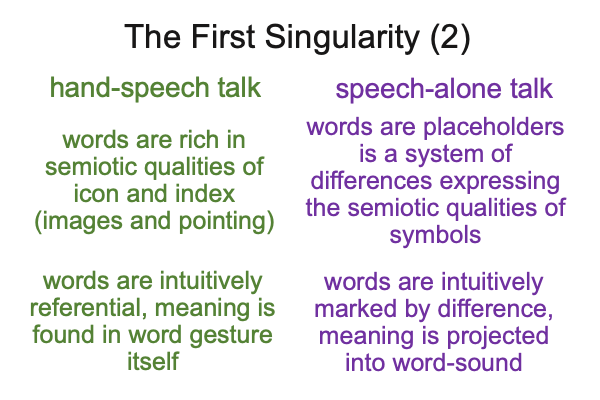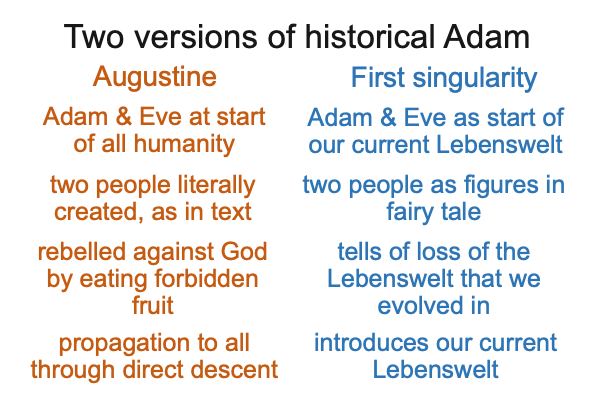0191 After the first singularity, speech-alone talk words are not grounded in pantomime and pointing. Anyone can mint a word for anything. This flexibility fosters labor and social specialization. Specialization increases the wealth and the power of the Ubaid.
Here is the transition in terms of the semiotic qualities of the different ways of talking.

0192 How does speech-alone talk spread?
Any Neolithic or late Paleolithic culture can see that the Ubaid has something that they do not have. First, the Ubaid has more wealth and power. Second, the Ubaid people do not talk with their hands.
0193 Speech-alone talk spreads through mimicry. It spreads like wildfire. It potentiates unconstrained complexity everywhere it is adopted.
Then, specializations increase wealth and power.
Then what happened?
The newly minted elites, typical of our current Lebenswelt, challenge the keepers of the Lebenswelt that we evolved in.
0194 Everything we knew from our evolution is forgotten.
Everything we know is forged in our current Lebenswelt.
0195 Imagine the darkness and confusion that follows the adoption of speech-alone talk.
Each infected population increases in number and becomes wealthier and more divided. At the same time, each population forgets who they are. They leave behind what they had evolved to be. A new priesthood, attending to manifold specialized deities, murders the holistic shamans who stand in the way of change.
Does this sound vaguely familiar?
0196 Writing is invented, maybe around 3000 U0’, in order to record economic transactions for the burgeoning temples and palaces. Fortunately, for archaeologists, the Sumerians write on clay tablets, which may crack but do not decay (like papyrus).
0197 Eventually, scribes record the public creation stories of these early civilizations on clay tablets. Some of these tablets are stored in royal libraries.
The written origin myths of the ancient Near East have one feature in common.
They cannot envision times before the trauma of the first singularity.
The same goes for the stories of Adam and Eve, surviving as fairy tales in a living tradition.
In this regard, the Creation Story of Genesis One is an anomaly. But, Genesis One comes from a different source than the stories of Adam and Eve. See Exercises in Artistic Concordism, by Razie Mah, available at smashwords and other e-book venues.
0198 And the final point?
The first singularity, a scientific hypothesis, offers something similar to Augustine’s version of Original Sin.

Christian theologians now face the task of proposing Augustine’s postmodern doctrine of Original Sin, the one that Augustine would have proposed if he had the hypothesis of the first singularity at hand.
